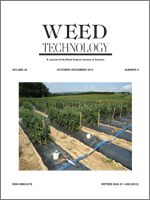The weed management needs of organic producers are unique because they rely primarily on cultural and physical management strategies. Recommendations regarding commonly used tools for weed management could benefit this sector of agriculture. The objectives of this research were to (1) determine the optimum time of day for propane flaming to achieve maximum weed reductions while minimizing corn damage; (2) assess whether flaming, rotary hoeing, or a combination of the two tools best manages early-season weeds without injuring dry beans; and (3) evaluate the use of growing degree days (GDD) to optimize rotary hoe timing. Experiments were carried out between 2006 and 2009 in Hickory Corners and East Lansing, MI. Flaming reduced broadleaf weed densities by at least 82% when done in the morning to midafternoon but only reduced densities by 58% when weeds were flamed in the evening. Common lambsquarters, redroot pigweed, and velvetleaf were easier to control by flaming than common ragweed and common purslane. Flaming did not reduce grass weed densities. When comparing flaming and rotary hoeing, the two treatments that achieved the highest level of weed control and highest dry bean yields were flaming prior to bean emergence followed by two rotary hoeings and rotary hoeing three times (no flaming). However, the added cost of the flamer may only be justified when wet conditions make rotary hoeing ineffective. Flaming dry beans POST resulted in significant injury and yield reductions of 60%; therefore this practice is not recommended. Timing rotary hoe passes every 300 GDD (base 3.3 C) from the time of soybean or dry bean planting resulted in fewer passes compared with the 7-d or 150 GDD treatments, while maintaining similar levels of weed control and yields similar to the weed-free treatment in 1 of 2 yr for each crop.
Nomenclature: Common lambsquarters, Chenopodium album L. CHEAL; common purslane, Portulaca oleracea L. POROL; common ragweed, Ambrosia artemisiifolia L. AMBEL; redroot pigweed, Amaranthus retroflexus L. AMARE; velvetleaf, Abutilon theophrasti Medik. ABUTH; corn, Zea mays L.; dry bean, Phaseolus vulgaris L.; soybean, Glycine max (L.) Merr.
Las necesidades de manejo de malezas de los productores orgánicos son únicas porque ellos dependen primordialmente de estrategias culturales y físicas. Las recomendaciones que consideren herramientas comúnmente utilizadas para el manejo de malezas podrían beneficiar a este sector de la agricultura. Los objetivos de esta investigación fueron: (1) determinar el momento óptimo del día para quemar con llamas de propano y alcanzar reducciones máximas en las poblaciones de malezas al tiempo que se minimiza el daño al maíz; (2) evaluar si las llamas, el cultivador rotativo, o la combinación de estas dos herramientas brinda el mejor manejo de malezas en la etapa temprana del cultivo sin dañar al frijol común; y (3) evaluar el uso de grados días de crecimiento (GDD) para optimizar el momento de uso del cultivador rotativo. Entre 2006 y 2009, se realizaron experimentos en Hickory Corners y East Lansing, MI. La quema con llamas realizada entre la mañana y media tarde redujo las densidades de malezas de hoja ancha en al menos 82%, pero solamente redujo las densidad en 58% cuando las malezas fueron quemadas en la noche. El control con llamas de Chenopodium album, Amaranthus retroflexus y Abutilon theophrasti fue más sencillo que el control de Ambrosia artemisiifolia y Portulaca oleracea. La quema con llamas no redujo las densidades de malezas gramíneas. Al comparar la quema con





